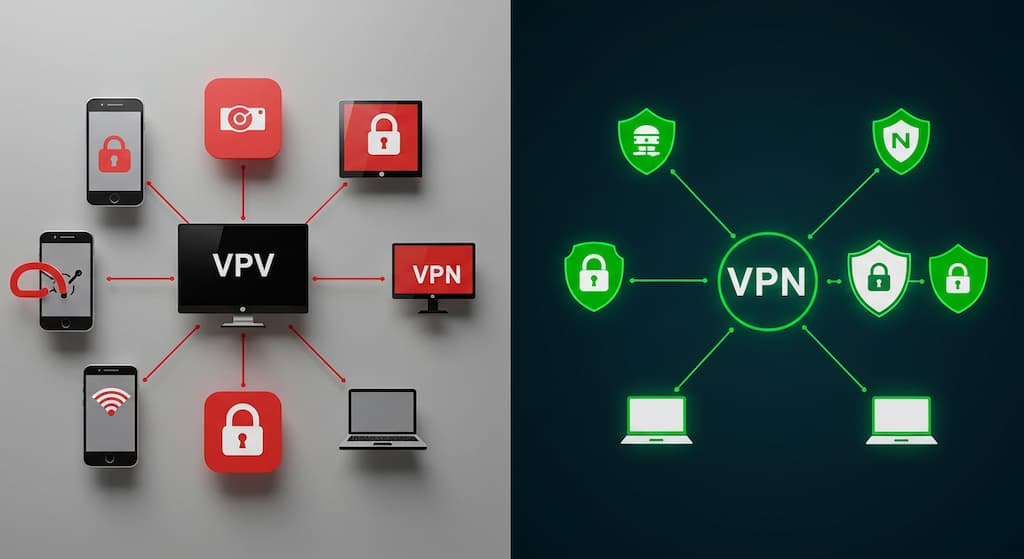How to Share Your VPN Connection from Windows, macOS, and Ubuntu
Sharing your CityStaticVPN connection from your computer allows other devices (like smart TVs, game consoles, or other computers) to benefit from the VPN, even if they don’t have native VPN support or you want to consolidate your VPN usage through one source. This guide will walk you through sharing your VPN connection via Wi-Fi (creating a hotspot) from your Windows, macOS, or Ubuntu PC.
Important Considerations Before You Start:
- Internet Source: For macOS and Linux, sharing a VPN connection over Wi-Fi when your computer is also connected to the internet via Wi-Fi (using the same Wi-Fi adapter) can be problematic or unsupported by the hardware. It’s generally recommended that your computer receives its internet connection via an Ethernet cable to then share it wirelessly. Alternatively, using a second Wi-Fi adapter (e.g., a USB Wi-Fi dongle) can resolve this – one for connecting to the internet and one for broadcasting the hotspot.
- Performance: Sharing a connection can reduce internet speeds on all connected devices, including the host computer, due to the overhead of routing and encryption.
- Security: Ensure you use a strong password for your Wi-Fi hotspot to prevent unauthorized access.
Sharing VPN from Windows
This method uses the built-in Mobile Hotspot feature in Windows.
- Connect to Your VPN: First, establish a connection to your desired VPN server using your VPN client software.
- Enable Mobile Hotspot:
- Go to
Settings>Network & Internet>Mobile hotspot. - Turn the “Share my Internet connection with other devices” toggle to
On. - Under “Share my Internet connection from,” ensure
Wi-FiorEthernetis selected (whichever is your computer’s internet source). - Under “Share over,”
Wi-Fishould be selected to broadcast a wireless hotspot. - Click
Editto set yourNetwork name(SSID) andNetwork password. Choose a strong password. ClickSave.
- Go to
- Configure VPN Adapter Sharing:
- Right-click the Start button and select
Network Connections(or openControl Panel>Network and Sharing Centerand clickChange adapter settingson the left). - You will see a list of network adapters. Identify your VPN connection’s adapter. It often includes the name of your VPN provider or terms like “TAP Adapter” or “VPN.”
- Right-click on your VPN adapter and select
Properties. - Go to the
Sharingtab. - Check the box that says, “Allow other network users to connect through this computer’s Internet connection.”
- Under “Home networking connection,” select the Mobile Hotspot adapter you just created. It might be named something like “Local Area Connection* X” or “Microsoft Wi-Fi Direct Virtual Adapter.” (To help identify it, you can check its name in the Network Connections list – it usually appears when the hotspot is active).
- Click
OK.
- Right-click the Start button and select
- Connect Devices: Other devices can now search for the Wi-Fi network name you set up and connect using the password you created. Their traffic should now be routed through your PC’s VPN connection.
Sharing VPN from macOS
macOS uses its “Internet Sharing” feature. As mentioned, this works best if your Mac is connected to the internet via Ethernet.
- Connect to Your VPN: Ensure your Mac is connected to your VPN service.
- Open Sharing Settings:
- Go to
System Settings(on newer macOS versions) orSystem Preferences(on older versions). - Click on
Generalin the sidebar (if using System Settings), then clickSharing. If using System Preferences, directly click onSharing.
- Go to
- Configure Internet Sharing:
- Select
Internet Sharingfrom the service list on the left (don’t check the box to enable it yet). - In the settings on the right:
- “Share your connection from:” Choose your active VPN connection from the dropdown menu. This might be the name of your VPN configuration (e.g., if you manually set up L2TP/IPSec) or the interface created by your VPN app (its name can vary).
- “To computers using:” Check the box for
Wi-Fi.
- Select
- Configure Wi-Fi Options:
- Click the
Wi-Fi Options...button. - Network Name: Enter a name for your new Wi-Fi hotspot.
- Channel: Leave as default or choose one if you have specific needs.
- Security: Select
WPA2/WPA3 PersonalorWPA2 Personalfor broader compatibility. - Password: Create a strong password for your hotspot.
- Verify: Re-enter the password.
- Click
OK.
- Click the
- Start Internet Sharing:
- Now, check the box next to
Internet Sharingin the service list. - A prompt will appear asking you to confirm you want to start Internet Sharing. Click
Start. - The status indicator next to “Internet Sharing” should turn green and show “On.”
- Now, check the box next to
- Connect Devices: Other devices can now find and connect to the Wi-Fi network you created, using the password you set.
Troubleshooting for macOS:
- If your VPN interface isn’t listed in “Share your connection from,” it might be due to how your VPN software creates its network interface. Some VPN apps (especially those using newer network extension frameworks) might not be directly sharable this way.
- Remember the limitation: if your Mac is using Wi-Fi for its internet, creating a Wi-Fi hotspot simultaneously on the same internal card is usually not possible. Use an Ethernet connection for your Mac’s internet or a second USB Wi-Fi adapter.
Sharing VPN from Ubuntu (Linux)
This method primarily uses NetworkManager, which is common in Ubuntu and its derivatives. As with macOS, it’s best if your Ubuntu machine is connected to the internet via Ethernet.
- Connect to Your VPN: Start your VPN connection using your VPN client or NetworkManager’s VPN settings.
- Create a Wi-Fi Hotspot and Share:
- Method 1: Using GNOME Desktop Settings (Simplest)
- Click on the system menu (usually top-right corner of the screen).
- Go to
Wi-Fi SettingsorNetwork. - Click the three-dot menu (or similar) and select
Turn On Wi-Fi Hotspot.... - A hotspot will be created with an automatically generated name (often based on your computer’s name) and password. You can usually edit these by clicking on the hotspot once created or through advanced network connection settings.
- This method should automatically share your active internet connection (including the VPN if it’s routing all traffic). However, to ensure the VPN is shared specifically, Method 2 might offer more explicit control.
- Method 2: Using Network Connection Editor (More Control)
- Open a terminal and type
nm-connection-editorand press Enter. This opens the “Network Connections” window. - Click the
+button to add a new connection. - Choose
Wi-Fias the connection type and clickCreate.... - In the
Wi-Fitab:- Connection name: Give it a descriptive name (e.g., “VPN Hotspot”).
- SSID: This will be the name of your Wi-Fi hotspot that other devices see.
- Mode: Select
Hotspot. - Device: Your Wi-Fi adapter should be selected (e.g., wlan0).
- Go to the
Wi-Fi Securitytab:- Select
WPA & WPA2 Personal(or WPA3 if your devices support it). - Create a strong Password.
- Select
- Go to the
IPv4 Settingstab:- Method: Change this from
Automatic (DHCP)toShared to other computers.
- Method: Change this from
- (Optional) Go to the
IPv6 Settingstab:- Method: You might want to set this to
DisabledorIgnoredif your VPN doesn’t support IPv6 well, to prevent potential leaks.
- Method: You might want to set this to
- Click
Save.
- Open a terminal and type
- Method 1: Using GNOME Desktop Settings (Simplest)
- Activate the Hotspot (if not already active):
- If you used Method 2, you might need to connect to this newly created hotspot profile from your Wi-Fi settings if it doesn’t activate automatically.
- Ensure IP Forwarding (If Needed):
- “Shared to other computers” usually handles this. If you encounter issues, ensure IP forwarding is enabled:
- Open a terminal and type:
sudo sysctl net.ipv4.ip_forward - If it returns
net.ipv4.ip_forward = 0, enable it with:sudo sysctl -w net.ipv4.ip_forward=1 - To make this permanent, edit
/etc/sysctl.conf(e.g.,sudo nano /etc/sysctl.conf), uncomment or addnet.ipv4.ip_forward=1, save the file, and then runsudo sysctl -p.
- Open a terminal and type:
- “Shared to other computers” usually handles this. If you encounter issues, ensure IP forwarding is enabled:
- Connect Devices: Your other devices should now be able to find the Wi-Fi hotspot SSID you configured and connect using the password.
Advanced Ubuntu/Linux (iptables): If the NetworkManager “Shared to other computers” method doesn’t work as expected, or for more granular control, you might need to configure NAT (Network Address Translation) and forwarding rules manually using iptables. This is more advanced and involves commands like: sudo iptables -t nat -A POSTROUTING -o <your_vpn_interface> -j MASQUERADE sudo iptables -A FORWARD -i <your_hotspot_interface> -o <your_vpn_interface> -m state --state RELATED,ESTABLISHED -j ACCEPT sudo iptables -A FORWARD -i <your_hotspot_interface> -o <your_vpn_interface> -j ACCEPT (Replace <your_vpn_interface> with your VPN’s network interface, e.g., tun0, and <your_hotspot_interface> with your Wi-Fi adapter’s interface when in hotspot mode, e.g., wlan0). These rules might need to be saved to persist after a reboot. This approach is generally for users comfortable with Linux command-line networking.
By following these steps, you should be able to share your computer’s VPN connection with other devices on your network. Remember to test if the connected devices are indeed using the VPN by checking their IP address on a site like whatismyip.com.


